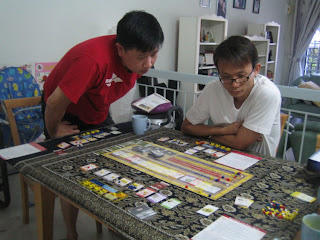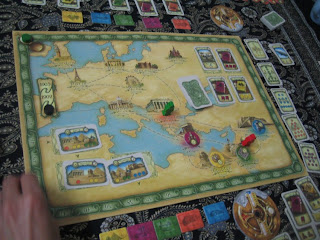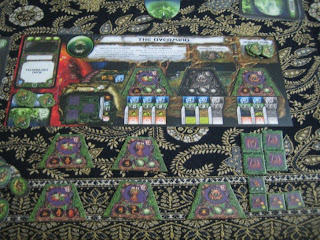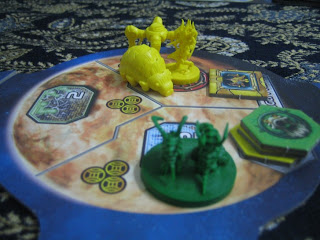On Sat 24 May 2008, Han and I played Axis & Allies: Guadalcanal, the latest in the family of Axis & Allies boardgames. This is my 6th Axis & Allies game. I have Axis & Allies (Milton Bradley 1984 version), Axis & Allies: Europe, Axis & Allies: Pacific, Axis & Allies (Wizards of the Coast 2004 revised version), Axis & Allies: Battle of the Bulge and Axis & Allies: Guadalcanal. The only boardgame in the series that I didn't buy is Axis & Allies: D-Day. It seemed rather scripted and I didn't like the idea. I bought Axis & Allies: Guadalcanal in December 2007 (I probably received it in Jan 2008), and this was the first time I played it.
Axis & Allies: Guadalcanal is set in World War II, in the Solomon Islands, in the south western Pacific Ocean. Guadalcanal is one of the islands in the island group. When the game starts, the island group is controlled by the Japanese, except for Guadalcanal, which has just been captured by the Americans. There are some frightened Japanese soldiers stranded on Guadalcanal, holding on to some supplies, and cut off from friendly units. The other islands are mostly lightly defended by the Japanese, but they have an armada of ships ready to transport in reinforcements. The Americans of course also have a big navy ready to invade, and one obvious advantage is the number of bombers that they have. The fleets of both sides are more or less equal.
The objective of the game is to be the first to reach 15 victory points. This is done by controlling airfields (the game starts with 2 but more can be built), and sinking capital ships, i.e. battleships and aircraft carriers. If both players reach or exceed 15pts at the same time, then whoever scores more wins. If they are still tied, then they continue to play until the tie is broken.

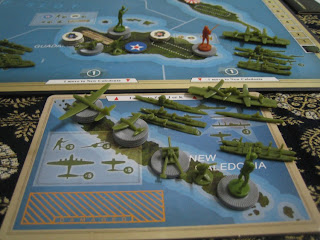




I played the Americans while Han played the Japanese. Since the Americans only control 1 island at the start of the game, compared to 5 islands controlled by the Japanese, I had planned to capture 2 more islands on the first turn, to even the playing field. This is important because the number of reinforcement points received at the end of each turn depends on the number of islands you control. Unfortunately Han made a strong reinforcement to New Georgia (one of the islands closer to the American side of the board which I had originally intended to capture), so I had to settle with controlling 2 islands at end of turn 1 rather than take too big a risk.
Our game was probably not played in the best way, since we were both new to the game. Despite being part of the Axis & Allies series, Axis & Allies: Guadalcanal is quite different and warrants a new look at strategy. You need to pick up the tactics all over again and cannot simply re-use those from other games in the series. We had a lot of big exciting showdowns, with ships and planes all crowding into the same sea zone, and lots and lots of casualties. I'm not sure whether this was the "correct" way to play, but at least I can say it was thrilling and fun. In an early battle, I wiped out almost the entire Japanese air force. My American air force also suffered severe losses, but I had more to start with, and some of the bombers survived to continue to wreak havoc. I kept taking photos of our big showdowns, until I lost track of which was which. Each time I thought that was going to be the game-ending decisive battle, enough units survived to keep the game interesting and the victory in contention. It was an exciting game.
In the early game, we built airfields, since these were key to scoring victory points. I had considered building them on islands in the middle of the board, so that I save space on my side of the board for safer future builds. However eventually I decided it was too risky to build too near the enemy and I chose the more conservative locations. Our airfield building were mostly on par, keeping our scores the same up to end of turn 3. On turn 4, Han built an airfield on one of the more central islands, Santa Isabel, and was then ahead of me in victory points. On turn 5 I amassed a large group of transports and infantry and artillery, and captured Santa Isabel successfully. Han did not have enough troops and transports in position to defend against such a large invading army. Controlling one more airfield than Han at the end of turn 5 would have only brought our scores even, since he was ahead of me by 1 point in turn 4. It was the sea battles involving the capital ships that decided the outcome of the game. I made a blunder with my battleship movement, moving it towards a group of innocent looking transports carrying juicy land units. I later changed my mind about where to move my other ships, and left my precious battleship in enemy infested waters. The captain must have been cursing me and my ancestors. The lone battleship was soon swarmed by the Japanese cruisers and planes.
In an adjacent sea zone, where Han had 2 carriers and 1 battleship, another big showdown was ready to begin too. I only had one cruiser there, since my destroyers could not reach there in time. However I did manage to send in 3 bombers and 4 fighters, against Han's 2 fighters. Aaah... the flexibility of aircraft, and the convenience provided by the carriers. Indeed World War II was the time when big battleships started to become obsolete, and carriers became the focus of naval warfare (if I got my military history right).
In the first battle, my battleship actually almost survived. Battleships have strong hulls and in the game, they can ignore the first hit. This was what happened to my battleship. Most ships are also resilient, i.e. if they are hit by a die-roll of 2, they are damaged and go back to base, as opposed to being outright destroyed if they are hit by a die-roll of 1. For my battleship, it was Han's 8th and last die that was a 1, which outright destroyed my battleship. That was the first capital ship sunk in the game. Ouch. In the next battle in the adjacent sea zone, enough of my planes survived the flak and air combat to deal a heavy blow to the Imperial Japanese Navy. Plus I also had a stack of artillery firing free shots at them from New Georgia. The battleship was sunk, and one of the carriers too. This was the decisive game-ending blow. End of turn 5, USA 17, Japan 16. Victory points by turns: USA 2, 3, 3, 3, 4+2, Japan 2, 3, 3, 4, 3+1.



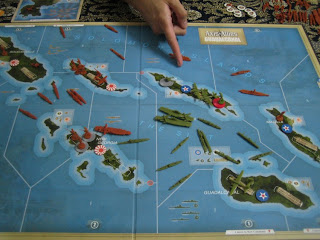
I really like Axis & Allies: Guadalcanal. If I were to try to summarise it with one word, the first word that comes to mind is "fluid". Maybe this is due to the contrast with other games in the Axis & Allies series (other more complex wargames may already have this characteristic, just that I have not played them). In Axis & Allies: Guadalcanal, there is no concept of pinning, i.e. if you are in the same area with enemies, or move into an area containing enemies, you are not forced to stay or stop. So you have to remember that you cannot pin down your enemy units, and also that your opponent cannot do the same to you. You cannot amass your units in one area, and then strike with all of them against an enemy group in an adjacent area. Your opponent can simply choose to disperse his units to avoid a head-to-head collision that is too risky for him. This is one big difference from previous games, and I quite like it. I guess this is more applicable to this arena and to a battle of this scale.
Another aspect that I like is how during a turn the players take turns to move a single type of units. The order is: transports, battleships, aircraft carriers, cruisers, destroyers, submarines, bombers and fighters (land units can only be carried by transports and destroyers). In previous Axis & Allies games, mostly one player moves all units before the next player makes his move. By having these alternating turns to move different types of units, there is a very interesting balance of watching what your opponent is doing and responding to it, and also being forced to commit your strategy when you yourself have to move your units before your opponent does so again next. The start player (Japan first, and then it alternates every game turn) would have a slight disadvantage because of being forced to commit first, but since you only have to move one type of units at a time, it is not too bad a disadvantage. The order of moving units is also very thematic. Transports, which must move earliest, are slow and clumsy and most vulnerable. Battleships and carriers which move next are often the core of your fleets, and are usually the most difficult to hide from enemy recon aircraft. Submarines move after all other ships, because they are sneaky bastards.
Having played the game, I have a feeling that controlling airfields is not important just from a victory point perspective, but also from a practical perspective. Aircraft in this game is important, powerful and flexible. Making good use of your airfields (and carriers) is and should be an important part of the game. In our game, we didn't make use of them a lot, and mostly thought of them as sources of victory points. Maybe this is a side effect of playing too many Eurogames. If we had made better use of our airfields we could probably have improved our play. This is a skill to hone. Aircraft is important in this game. They are not very expensive, which is probably intentional, to encourage players to make use of them. The most important feature of aircraft is their flexibility. They move last compared to other units. Bombers can move 3 spaces, and fighters 2 spaces, as opposed to ships which all move 1 space. So after all the ships have moved, you can identify where the hot spots are, and allocate your aircraft accordingly. With that said, aircraft are not overpowered either. When combat is conducted, everyone fires at aircraft first, and casualties are removed before moving on to the sea attack step. So you need to make sure you bring enough planes, lest they all get shot down by flak and enemy aircraft. In this way, air units are vulnerable. It is also important to have enough fighters to protect your bombers. Fighters are good at aerial dogfights with enemy fighters and bombers, and thus are important in the air attack step. Bombers are effective against sea and land units (and bombing airfields), so hopefully enough of them survive the air attack to come to good use. The presence of fighters may also help to take hits which otherwise may hit the bombers. The combat resolution mechanism in the game is interesting, but I won't go into details. It is in a way similar to Axis & Allies: Battle of the Bulge, where casualties are usually not chosen by the side losing the units, like in other Axis & Allies games. I think it's clever, thematic, and probably more realistic too.
Because of the combat resolution mechanism, one should bring along cheap destroyers with any fleet whenever possible. Often they are the ones that get hit first. They "take one for the team". In contrast, transports are the most protected ships in a fleet with multiple ship types. That makes sense too, since in this game they carry valuable "cargo", the land units and the supplies needed to fight for control of the islands and build and repair airfields. Transports are no longer the cannon fodder often used in other Axis & Allies games. In fact sometimes I wished they could help more in taking some hits since in our game I had more than enough of them. I don't think I lost a single transport throughout the whole game. I guess they had been scurrying in the safe back alley and they stayed far away from the hot spots.
Capital ships are actually not that easy to sink. Battleships ignore the first hit. Both battleships and carriers are damaged instead of destroyed if hit by a 2 (destroyed by 1). And because of the combat resolution mechanism, sometimes destroyers and cruisers take hits for them, especially considering you usually won't leave a capital ship unprotected (well, what I did in our game was not the best example...).
Another interesting aspect of the game is forward deployment. When building new units at your base, you can spend supply tokens to directly deploy them onto the board, instead of having to move them from your base to the board on the next turn. This can be important to get your troops out there to the hot spots quickly. It is not exactly cheap to do so, but sometimes it is worth it. I used this quite a few times in our game. I think Han used this less. One thing that neither of us did at all was trying to damage airfields. We did have the opportunity to do so, but we never got around to actually doing it. Maybe we didn't plan for it and thus didn't have enough units in position to have a reasonable chance of success, so we didn't risk it. Maybe we should have made a more concerted effort to bomb enemy airfields. I have a feeling this is an important thing to do to play this game well. Denying your opponent one victory point can be the difference between winning and losing.
Two other interesting features are multiple attacks and free shots. Since combats are divided into 3 steps, air, sea and land, units which can attack in all three steps (e.g. aircraft, battleships) are, in a way, better value for money than those which can only attack in one step (e.g. infantry, submarine). But of course this is assuming they survive to the next step. Free shots are when battleships and cruisers do shore bombardment, and when artillery fire at ships in adjacent sea zones. I'm not too sure how realistic the latter is, but anyway this free shot thing is an interesting consideration in the game, about where to position your battleships and cruisers to take advantage of it, and whether to buy and where to place artillery to take advantage of it.
All in all, I find Axis & Allies: Guadalcanal quite different from previous games in the family, and quite a good game too. Definitely a good purchase. It seems with the latest two Axis & Allies games (the other one being Axis & Allies: Battle of the Bulge), Larry Harris, the designer, was trying to make games quite different from the base game, and I like the result so far. The next game in the series is a deluxe anniversary edition of the world wide arena game, i.e. we are back to the world map. I wonder whether there will be many new innovations. I suspect there won't be too many. This one will have Italy as the sixth playable country. That should be interesting. I have already decided to buy this. I'm a fan.
We have been playing more of Race for the Galaxy. When Han is here, and also as 2-player games with Michelle. All 3 of us like this a lot. So many interesting decisions in so short a time. I have played 18 games now. This is nothing compared to those who have played hundreds of games, but I am quite sure I will hit 100 games one day. I have played San Juan 58 times. The only other games that I have played more than 100 times are Mystery Rummy: Jack the Ripper, Carcassonne (not counting the variations like The Castle, The City, Hunters and Gatherers etc, but counting expansions to the base game like Inns & Cathedrals), and Ticket To Ride (not counting independent standalones like TTR Europe, TTR Marklin and TTR Switzerland, but counting TTR USA 1910). Even Michelle is keen about the 2 upcoming Race for the Galaxy expansions.





